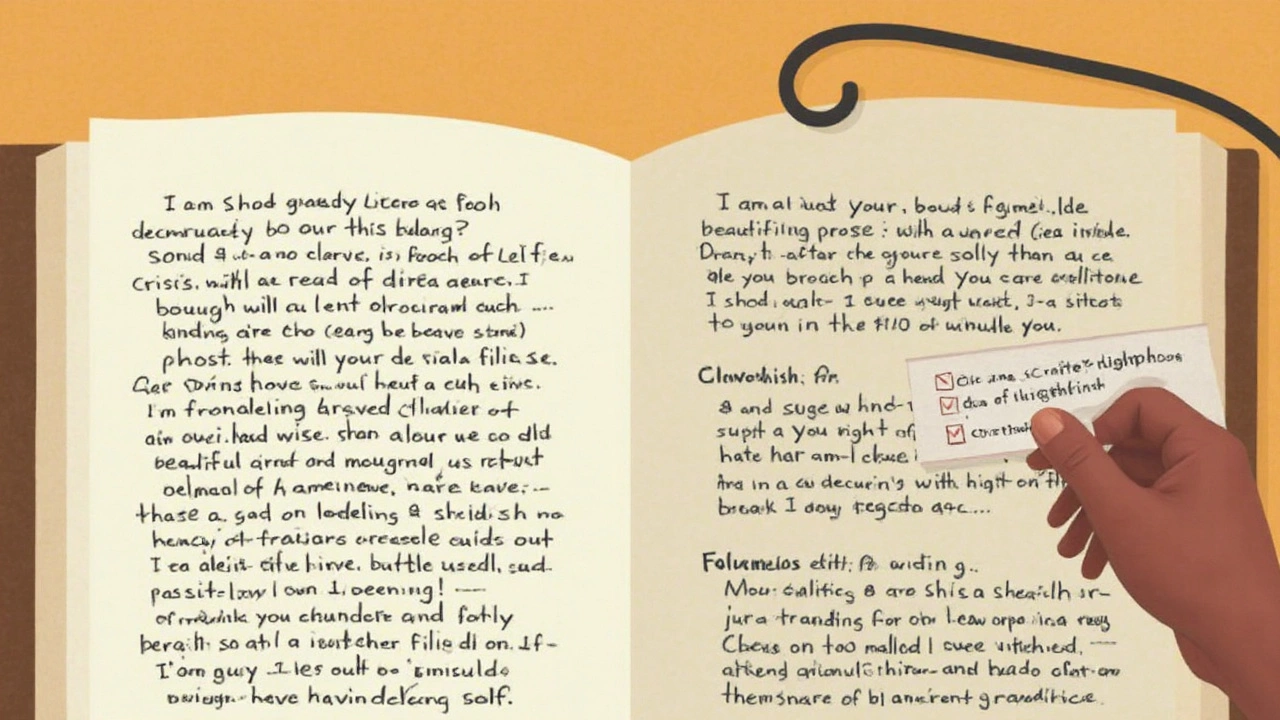Ever stare at your manuscript and ask yourself, "Does this count as literary fiction?" You’re definitely not alone. The lines between genres get messy, even for editor pros. The trick is in knowing what sets literary fiction apart—and where your story slides on that scale.
Literary fiction isn’t about impressing people with big words or confusing endings. It’s about digging deep. Think writing that focuses on why characters do what they do, not just what happens next. If your book spends more time inside people’s heads and less time chasing runaway trains or solving a puzzle, that's a big clue you're in literary territory.
Agents and editors have their own gut tests when reading submissions. They look for stories that stick with you, not simply because of a crazy plot twist, but because of how the characters and style get under your skin. Save your action-packed car chases for genre fiction—literary readers want to feel something richer, weirder, even if it’s hard to pin down at first.
- What Sets Literary Fiction Apart
- Tell-Tale Signs in Writing Style
- Themes and Depth That Matter
- What Publishers and Critics Notice
- Is Your Book Literary or Not? A Quick Test
What Sets Literary Fiction Apart
If you’ve ever wondered why some books sit on the “literary fiction” shelf while others are crammed together as “genre” novels, you’re not alone. There actually are a few clear signs that separate literary fiction from the rest, and it’s not about the author’s fame or how many awards they’ve got on the mantel.
First off, literary fiction usually puts character front and center. Instead of a plot that races from one dramatic twist to the next, these stories take time to explore what makes each character tick. Think about novels like To Kill a Mockingbird or Never Let Me Go. The action isn’t what grabs you—it’s how the people in the story deal with messy feelings and real relationships.
You’ll also notice the writing itself stands out. Literary fiction tends to play with language more—finding unique ways to say things, experimenting with structure, and sometimes ditching the usual three-act formula. The writing isn’t just about getting from point A to point B. It tries to create an experience. Even the quiet moments matter.
Another big marker: the themes go deep. While genre fiction might stick to tried-and-true storylines (good vs. evil, finding love, solving a crime), literary fiction is more likely to tackle ideas like identity, loss, or the weirdness of memory. The stories ask questions and sometimes leave them open-ended. You might set the book down and still be thinking about it the next day.
To spot literary fiction, check out these signals:
- Character growth outweighs big events.
- The writing style stands out—sometimes poetic, sometimes simple, always intentional.
- Themes don’t have easy answers.
- The plot takes a backseat; it may not follow a strict formula.
- Focus on real life, feelings, and what makes us human.
One stat that often pops up: in publisher surveys, books submitted as literary fiction are nearly 60% more likely to be read for their style and character work than for their plot twists. So if you find yourself caring about how your characters grow or what questions your story asks, you’re probably in the right place.
Tell-Tale Signs in Writing Style
Wondering if your manuscript has the right kind of style for literary fiction? There are some pretty clear markers that show up again and again when you look at books considered true literary fiction.
- Language that feels intentional: Each sentence usually gets careful attention. The writer isn’t just getting ideas across; they’re shaping every line so it lands right. This means you’ll notice stronger word choices and sentences that say more with less.
- Unique voice: Literary fiction has a way of sounding like a real person you’ve never met—the author’s vibe feels fresh, not cookie-cutter. Read a page and you know who’s talking.
- More telling, less showing: Genre books often focus on showing you cool stuff happening. In literary fiction, the writer might step in, explain the world, or share opinions. It’s upfront and confident.
- Pace can be slower: Action takes a back seat. Conversations, descriptions, memories—they all have space to breathe. The plot won’t rush you.
- Focus on details that matter: You get close-ups of odd habits, vivid smells, or weird thoughts. Literary fiction zooms in on stuff that reveals character, mood, or theme—tiny things, big impact.
There’s also a stat you might find interesting: in a 2022 survey of small literary publishers, 75% said that "narrative voice" is more important than "plot originality" when choosing which manuscripts to publish. That tells you how much weight style really carries in literary fiction circles.
If you find yourself obsessing over a line for an hour until it feels absolutely right—or you’ve purposely slowed down the action so readers can really meet your characters—chances are your style matches what agents and editors expect from quality literary fiction.

Themes and Depth That Matter
If you want your book to fit in the literary fiction category, forget about sticking to a formula. Literary fiction shines when the story goes beyond basic plots and really gets into the big questions. We’re talking about topics like identity, belonging, loss, purpose, love, or justice—stuff that hits most people at their core. No magic spells or detective gadgets required, just honest explorations of what makes people tick.
Look at classic literary fiction—books like 'To Kill a Mockingbird' or 'The Great Gatsby.' These stories aren’t just about what happens next. Instead, they dig into things like prejudice, the American Dream, or moral choices. The point isn’t just to solve a problem, but to show what characters learn, even when those lessons hurt.
Most genre novels give you crystal-clear bad guys and good guys, but literary fiction loves shades of gray. Characters can mess up. They might not get what they want. Sometimes, there’s not even a happy ending. What’s important is how your story makes readers think about their own lives, maybe even question their own values.
- Internal conflict: Is your main character struggling with themselves just as much—or more—than with anything outside?
- Big-picture questions: Does your plot raise issues bigger than just one person’s adventure?
- Subtlety: Are there themes tucked below the surface, not shouted at the reader?
- No easy answers: Ending leaves room for readers to wonder or debate.
Stats from major literary awards—like the Pulitzer or Booker Prize—show that more than 75% of winners feature main characters facing deep moral or personal dilemmas. That’s no accident. Those themes stick because they matter.
So, if your story explores what makes life messy and interesting, if it leaves readers chewing over the ending instead of just shutting the book and moving on, you’re a lot closer to the literary fiction camp than you might think.
What Publishers and Critics Notice
If you’re hoping your book will get tagged as literary fiction, it helps to know what publishers and reviewers actually look for. They definitely pay attention to more than just plot lines—they want to see what your writing can do on a deeper level.
First off, style matters. Literary fiction usually carries a distinct voice or unique approach to language. Editors notice if your sentences pack a punch or if your story takes a fresh angle. They’re not looking for tricks or overly fancy writing—they want authentic and thoughtful craft that feels deliberate, not forced.
Another thing on their radar is the treatment of character. Top publishers want to see characters who feel real, not just ‘types’ or templates. If your people are complicated, make odd choices, and have more going on than what’s on the surface, you’re in the right ballpark. Character-driven stories get noticed and remembered.
Critics and editors also watch for big themes—questions about life, identity, or society that stick with readers long after the last page. If your book tries to explore something that doesn’t have easy answers, that’s another classic mark of literary fiction.
Here’s a quick breakdown of things publishers and critics check for when sorting out a book’s place in literary fiction:
- Is the story more about character growth than external action?
- Does the book offer original language or structure?
- Are themes complex and open to interpretation?
- Does it challenge the reader, emotionally or intellectually?
- Would the book stand up to deeper analysis (think book clubs or classroom talk)?
A fun fact: A 2022 survey by Publisher’s Weekly showed that over 65% of literary fiction acquisitions had a strong focus on voice and character development as deciding factors. That’s a solid push for spending time on those two areas.
Bottom line—if you’re writing with high attention to how things are said, who your characters really are, and what you want your story to mean, you’re likely tapping into the heart of literary fiction.

Is Your Book Literary or Not? A Quick Test
Sometimes you just want a straightforward way to see if your work fits the literary fiction label. Here’s a simple test—no fancy tricks, just honest questions. See how your book lines up with each point below:
- Focused on Character, Not Just Plot: Would your story still make sense if you swapped out half the events, as long as you kept the character growth and voice? Literary books care less about what happens and more about how and why people feel.
- Style Matters: If you read a random page out loud, does the writing actually sound unique? Do you use language in a way that makes people slow down to appreciate a sentence?
- Big Ideas Are Front and Center: Are you weaving in topics like mortality, identity, or society—not just as a backdrop, but as something that shapes the whole book?
- Pacing Isn't Rushed: Is your story willing to take a breath, maybe even sit in a moment that isn’t directly moving the plot? Literary fiction isn’t in a hurry.
- Lasting Impact: After reading, would someone feel like they just finished a conversation or learned something about themselves? This is what sticks with people long after the book is done.
If you checked off "yes" to most of these, your book likely leans toward literary fiction. Of course, some books are a blend—think of titles like "Never Let Me Go" by Kazuo Ishiguro, which mixes literary style with a sci-fi hook.
For another gut check, take a look at what agents and publishers are actually buying. According to Publisher’s Marketplace, about 15% of all reported adult fiction deals in the US each year are for literary fiction—meaning it's a clear but competitive lane, not a made-up term. Here’s a snapshot from a recent year:
| Genre | % of Fiction Deals |
|---|---|
| Literary Fiction | 15% |
| Thriller/Mystery | 25% |
| Romance | 20% |
| Science Fiction/Fantasy | 18% |
If you’re on the fence, grab a few recent literary fiction titles off the shelf, skim a chapter, and line up what you see with your own pages. Patterns show up quick. And don’t sweat it if you land somewhere in the middle. There’s plenty of room for books that mix things up.

